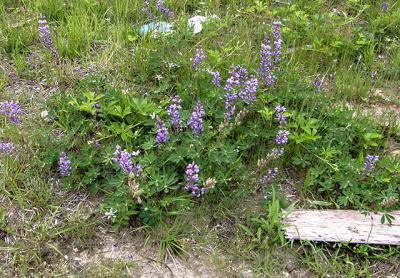Nature Notes: Our Own Highway 61

I went out looking for signs of gypsy moth infestations on Sunday, exploring the oak-hickory and oak-pine forests along the major Sag Harbor, Bridgehampton, Wainscott, and Northwest Woods roads.
Their favorite species, the white oaks, were well represented — still in flower and expanding their fresh, still-drooping pale green or reddish leaves. The good news is that I did not find any sign of gypsy moth caterpillars along the way, not even at a small spot on Route 114 between East Hampton and Sag Harbor where they were rampant by this time of year in 2015.
It’s still a bit early, so I’ll make the rounds again in another week or so.
I stopped by Daniel’s Hole on the northwest side of the road of the same name. There was only a bit of water, but several plants were blooming along the side of the road. I was also looking to see if the dreaded southern pine borer beetle was working on the pitch pines there. Thank God, I couldn’t find any of these little destroyers.
While I was there a chopper flew over, blasting the area below with an incessant horrible sound. I don’t live near the East Hampton Airport, but I got an earful of what those who do endure during several hours of each day. I myself, a product of the quiet ambience of Mattituck on the North Fork, would never be able to stand it.
I could also hear the banging of the guns at the Maidstone Gun Club north of the airport, and thought to myself, “Well, if you are going to have two very noisy areas in an otherwise quiet hamlet, you might as well locate them next to each other.”
When I passed the airport, three helicopters were on the ground with their rotors a-twirl, another was landing, and one had just taken off. A small transport plane with about eight windows on each side was just taking off and a two-engine jet was sitting at the beginning of the runway.
I made my way west along Industrial Road, anxious to see the state of the large cleared area that the Town of East Hampton leased to Landscape Details. When I last saw it months ago, it was clear, without any buildings or other improvements. Today, it was covered with buildings and roads and open areas. I could see an exhaust fan turning near the top of one building. There were several enormous pieces of a trunk that looked like it came from a beech tree; their cut ends were at least five feet across.
I left that site and turned north onto Town Line Road, and a new adventure was underway. I was looking for a spot where the wild blue lupine bloomed and was overjoyed when I found it there at the very end of the airfield. It was larger than ever and very verdant, despite being surrounded by garbage and debris of every description, as if it were undergoing one of those rebirth phenomena. I thought back to the 1980s and 1990s when wild lupine coated the shoulders of Daniel’s Hole, Two Holes of Water, Old Northwest, and Hand’s Creek Roads and the wooded section of Stephen Hand’s Path. No other town on Long Island could boast such a wonderful display of blue blossoms, and following on the heels of another blue wildflower, the bird’s foot violet, on some roadsides.
Suddenly it dawned on me: Highway maintenance did away with most of those wildflowers, but there is almost no highway maintenance on Town Line Road, half of which is owned by Southampton Town, half by East Hampton. Thus, the abundance of numerous throwaways on the roadsides. And what a view looking east through the airport fence of the town’s largest prairie — more than 100 acres of almost all native grasses and herbs, some endangered and threatened, a beautiful sea of different hues, including the blues of lupines, with not a single tree. No wonder the bluebirds and tree swallows thrive here.
As I left the prairie and progressed farther north along the up-and-down mostly unpaved road, I encountered large puddle after large puddle filling the washer-board depressions, and feasted my eyes on the lush greenery on either side, but also on the leavings of a society in the throes of degeneration. I thought of Bob Dylan’s Highway 61 Revisited and one if its verses to be quite apropros:
“Well, Mack the Finger said to Louie the King
‘I got forty red-white-and-blue shoestrings
And a thousand telephones that don’t ring
Do you know where I can get rid of these things?’
And Louie the King said, ‘Let me think for a minute, son’
Then he said, ‘Yes, I think it can be easily done
Just take everything down to Highway 61’ ”
Along with the weeds and lush native trees, shrubs, herbs, ferns, grasses, and wild blue lupines, just about everything there is is strewn along Town Line Road, our own Highway 61. It’s a potpourri of the good, the bad, and the ugly.
Larry Penny can be reached via email at [email protected].
